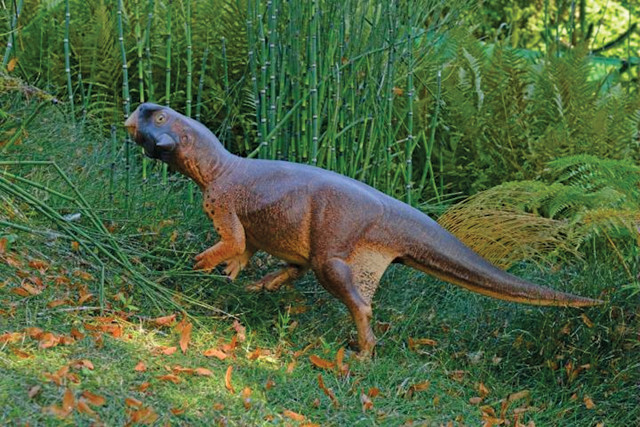
by Mary Caperton Morton Tuesday, December 27, 2016

An artist's illustration of a camouflaged Psittacosaurus. Credit: Jakob Vinther, University of Bristol, and Bob Nicholls (Paleocreations.com).
Analysis of a finely preserved fossil dinosaur from China has revealed the animal’s erstwhile camouflage. It appears that the meter-high Early Cretaceous ceratopsid Psittacosaurus was light-colored on its underside and dark on top, a pattern known as countershading that may hint that the small herbivore lived in a dense forest environment.
For decades, tiny specks found in some fossils were thought to be artifacts or bacteria; now, they are recognized as melanosomes, small structures in cells that carry melanin pigments. These relics of coloration have since been found in the fossil feathers and skin of many animals. By studying the pattern of melanosomes in a well-preserved Psittacosaurus specimen, researchers reconstructed a detailed depiction of the dinosaur, reporting their findings in Current Biology.
“The fossil preserves clear countershading, which has been shown to function by counter-illuminating shadows on a body, thus making an animal appear optically flat to the eye of the beholder,” said lead author Jakob Vinther of the University of Bristol in England in a statement. Countershading is typically seen in prey animals that live in low-light environments, such as under a dense forest canopy. The camouflage works against predators that use patterns of shadows on a surface to determine the shapes of objects.
Psittacosaurus is one of the most well-known fossils from Asia, having been uncovered throughout China in stratigraphic layers that also hold plant and wood remains. Other species closely related to Psittacosaurus have also been found in strata that appear to preserve former savannas, which could suggest that these animals’ coloration patterns may have been different.
© 2008-2021. All rights reserved. Any copying, redistribution or retransmission of any of the contents of this service without the expressed written permission of the American Geosciences Institute is expressly prohibited. Click here for all copyright requests.